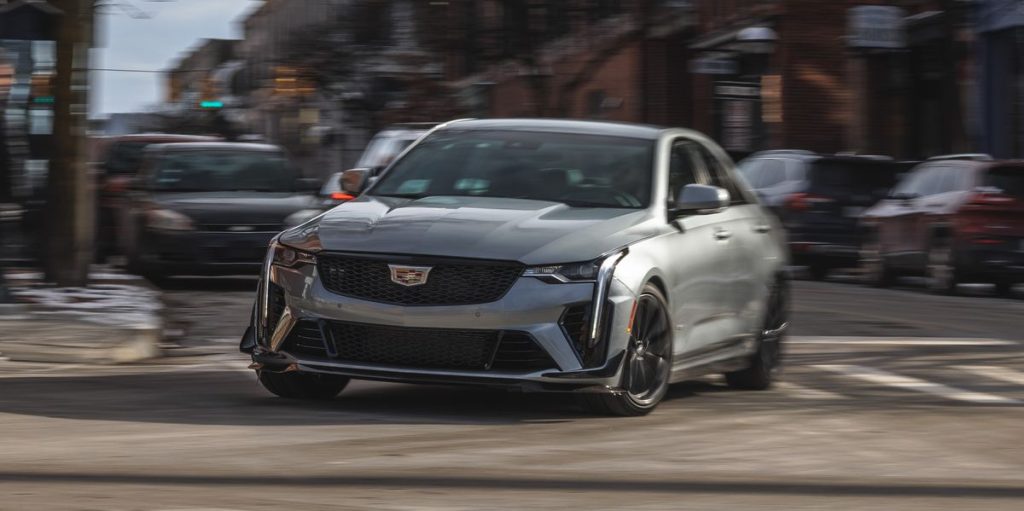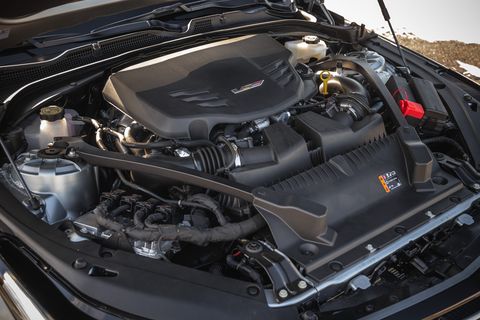Tested: Is the Cadillac CT4-V Blackwing Automatic a Better Supersedan?

This story is, with a nod to Charles Dickens, a tale of two transmissions: a six-speed manual and a 10-speed automatic. They’re both available in the 10Best-winning Cadillac CT4-V Blackwing. As we’re constantly promoting the joy of shifting your own gears—the engagement of gear engagement—and carping about cars that should offer manuals but don’t, this particular sports sedan caused us a rare moment of self-reflection.
Are we right in our hidebound belief that, like clothes making the man or woman, a manual gearbox makes the car? Could an all-around brilliant performance sedan like the CT4-V Blackwing be nearly as lust-worthy with an automatic as with a DIY gearbox? We ordered up an automatic CT4-V Blackwing to explore this knotty emotional conundrum.
We already know the manual-transmission CT4-V Blackwing like an old friend; we have one for a long-term test and have put more than 10,000 miles on it. That’s a lot of shifting and clutching, and we regret none of it. The Blackwing’s six-speed manual is one of the best, reminiscent of the sweet units bolted into various BMW 3-series models through the years. The Caddy’s gearbox has the same direct, well-oiled feel and solid shift linkage, which makes it a pleasure to row. The clutch-pedal takeup is intuitive and perfectly weighted. And of course, the manual transmission is at work in one of the world’s best sports sedans.
HIGHS: One of the two best sports sedans on the market (the other is a Caddy too).
Same for the Blackwing automatic. The CT4-V Blackwing is, aside from its 10-speed automatic gearbox, virtually identical to the manual model. It has the same 3.6 liters of twin-turbocharged V-6 muscle under the hood churning out 472 horsepower and 445 pound-feet of torque. For the record, manual-transmission Blackwings get lightweight titanium connecting rods to help their V-6s spin up faster, but it’s not a difference you can feel from behind the wheel.
The important performance equipment is otherwise identical, starting with rear-wheel drive (AWD is not available) and including sticky summer tires—255/35ZR-18 front and 275/35ZR-18 rear Michelin Pilot Sport 4S’s—plus big Brembo brakes and adaptive magnetorheological dampers. There are a dizzying number of ways to fine-tune the ride, handling, and traction control between the four drive modes, two customizable modes, and five steps in the Performance Traction Management system. No matter the transmission, though, the CT4-V BW is a virtuoso both on the road and on a racecourse.
More on the CT4-V Blackwing
Our $84,715 automatic tester had more options on it than our long-term car. Beyond the $2275 extra for the automatic, getting the auto forces $900 for additional driver-assist tech. Our car also had the performance data and video recorder setup ($1600) and a Technology pack that included an air ionizer and head-up display ($725). But the only extra that could potentially affect performance—beyond the automatic, of course—was the Carbon Fiber 1 package ($6150), which slaps a bigger spoiler on the trunk lid and adds a splitter, dive planes, and front-wheel air deflectors to the front fascia. This car also had the cosmetic Carbon Fiber 2 package ($4450) that adds carbon rocker-panel skirts and a rear valence extension.
Michael Simari|Car and Driver
These aerodynamic helpers no doubt increase downforce at higher speeds, but they also almost certainly increase drag, which we think showed up in the performance results. Even with its extra equipment, though, the 3904-pound automatic car weighed just 25 pounds more than the manual model, which means that weight differences were hardly a factor at the test track.
LOWS: Cramped rear seat, uninspired interior design, doesn’t get the credit it deserves.
Over the years, our instrumented testing has consistently shown that automatic-equipped models almost always outperform their otherwise-identical manual-transmission siblings. This Blackwing automatic did too, but the gap wasn’t as large as we would have predicted.
Against the clock, the automatic snaps off a 4.0-second 60-mph time; the manual hangs close at 4.1 seconds. The automatic shoots ahead from there, reaching 100 mph in 9.4 seconds to the manual’s 9.9 seconds. But then the manual begins to close the gap, trailing the automatic’s 12.4-second quarter-mile time by just 0.2 second, with both cars traveling an identical 114 mph. By 130 mph it’s a dead heat, with both cars taking 17.2 seconds to get there. That’s probably a result of the automatic car’s additional aerodynamic drag working against it as speeds rise into the triple digits. Differences in gearing may have also played a part. But the numbers don’t lie: The two transmissions deliver near-identical performance.
There’s not much difference in fuel economy either. Automatic CT4-V Blackwings ring up EPA ratings of 16 mpg city/24 mpg highway, while manual cars come in exactly 1 mile per gallon less in both measures. Not that a single mile per gallon matters when you’re piloting a 472-hp sedan with a manufacturer-claimed top speed of 189 mph.

Michael Simari|Car and Driver
Far more important than the automatic’s minuscule advantages in 60-mph acceleration or fuel economy is how it drives. Its transmission might have 10 speeds, but you’d never know it given how unobtrusively it steps through them in normal driving. Thankfully, it never lets the engine lug into the lazy, close-to-idle zone, and it’s ready with instant multi-gear downshifts when you press even halfway into the throttle. Drop your right foot quickly at any speed and the Caddy blasts off; quick passes on two-lanes or zipping through holes in traffic is effortless. When you want to play Lewis Hamilton, flick the gearbox into manual mode and the 10-speed responds quickly to the paddles’ calls for upshifts and downshifts. It can’t match the lightning shift speed of the best dual-clutch automatics, but it’s not far off.
In a way, the automatic expands this car’s already expansive bandwidth. You can be lazy and shift-averse at in-town speeds and in the bumper-to-bumper rush-hour crawl, and then enjoy gear-swapping, paddle-shifting fun when you want to play back-road hero. The CT4-V Blackwing is so accomplished that it would take a pretty awful automatic to change our mind about its high-wattage brilliance.
But stepping back into our manual-transmission long-termer quickly reminded us of the reason we worship at the Church of the Holy Stick Shift: the connection between driver and car. You feel the engine’s vibrations through the shift lever. You have to pay greater attention to traffic and anticipate what gear you’ll need next, so you’re more integral to the process of driving, more involved and in control. And there’s a wonderful sense of mastery to driving a manual gearbox adroitly, executing well-coordinated upshifts and smooth, rev-matched, heel-and-toe downshifts—without the help of electronic rev-matching. You don’t need to be banging gears and trying to yank the shift lever out of the floor; you can enjoy the manual’s involvement at any speed.
VERDICT: A great automatic, but give us our CT4-V Blackwing with the manual.
All of this leads to one simple conclusion: We’d still love the CT4-V Blackwing if it came only with an automatic transmission. But we love it more with a manual.
Specifications
Specifications
2023 Cadillac CT4-V Blackwing
Vehicle Type: front-engine, rear-wheel-drive, 5-passenger, 4-door sedan
PRICE
Base/As Tested: $61,890/$84,715
Options: Carbon Fiber 1 package (carbon-fiber front splitter, wheel deflectors, dive planes, rear spoiler), $6150; Jet Black leather upholstery with Jet Black accents, $4900; Carbon Fiber 2 package (carbon-fiber rocker extensions and rear-fascia diffuser), $4450; 10-speed automatic transmission, $2275; performance data and video recorder, $1600; Driver Assist package (adaptive cruise control, front and rear automatic emergency braking), $900; Technology package (air ionizer and head-up display), $725; Argent Silver Metallic paint, $625; 18-inch aluminum wheels with satin graphite finish, $600; Climate package (heated and ventilated front seats with massage, heated steering wheel) $600
ENGINE
twin-turbocharged and intercooled DOHC 24-valve V-6, aluminum block and heads, direct fuel injection
Displacement: 218 in3, 3564 cm3
Power: 472 hp @ 5750 rpm
Torque: 445 lb-ft @ 3500 rpm
TRANSMISSION
10-speed automatic
CHASSIS
Suspension, F/R: struts/multilink
Brakes, F/R: 15.0-in vented disc/13.4-in vented disc
Tires: Michelin Pilot Sport 4S
F: 255/35ZR-18 (94Y) TPC Spec 3164
R: 275/35ZR-18 (99Y) TPC Spec 3165
DIMENSIONS
Wheelbase: 109.3 in
Length: 187.6 in
Width: 71.5 in
Height: 56.0 in
Passenger Volume: 90 ft3
Trunk Volume: 11 ft3
Curb Weight: 3904 lb
C/D TEST RESULTS
60 mph: 4.0 sec
100 mph: 9.4 sec
1/4-Mile: 12.4 sec @ 114 mph
130 mph: 17.2 sec
Results above omit 1-ft rollout of 0.3 sec.
Rolling Start, 5–60 mph: 4.4 sec
Top Gear, 30–50 mph: 2.2 sec
Top Gear, 50–70 mph: 2.6 sec
Top Speed (mfr’s claim): 189 mph
Braking, 70–0 mph: 158 ft
Braking, 100–0 mph: 303 ft
Roadholding, 300-ft Skidpad: 1.04 g
C/D FUEL ECONOMY
Observed: 15 mpg
75-mph Highway Driving: 25 mpg
75-mph Highway Range: 430 mi
EPA FUEL ECONOMY
Combined/City/Highway: 19/16/24 mpg
C/D TESTING EXPLAINED
This content is imported from OpenWeb. You may be able to find the same content in another format, or you may be able to find more information, at their web site.



